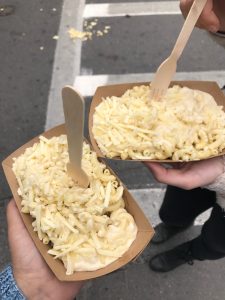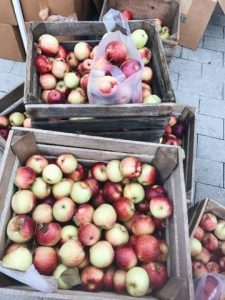I think I read once that if you ask people to name a fruit, the one they are most likely to come up with is “Apple.” It seems fair to say that apples are the archetypical fruit. But, upon closer inspection, our relationship to apples is unique.
At least in New England, apples are not just a food, they are part of a cultural experience. Because apples are grown locally, there’s a seasonality to them: you can buy apples all year round, but Apple Season is the Fall. I remember going apple picking with my family as a child; in my mind, the experience is linked with hayrides and pumpkin picking and Halloween.
What I’m getting at is, apples are concrete for me in a way that other fruits are not. Bananas and oranges are just foods. You pick them up at the supermarket, you bring them home, and you eat them. But apples are a part of life.
Before we went to Apple Fest, Prof. Blalock played us a podcast about “Club” apple varieties. Club apples are trademarked, and only a select club of growers are allowed to grow and sell them under the trademarked name. Prof. Blalock then took us through the names for two apple varieties, RubyFrost and SnapDragon. Why Ruby Frost? Ruby for the dark red skin, and frost both for the white interior and in reference to the late harvest. Frankly, I found the exercise kind of ridiculous. Putting that much thought into the name of an apple seems to me like wasted effort. I also learned that an apple variety which I thought was called “Sweet Tango” is spelled “SweeTango”, which is just an unnecessary affront to the English language.
However, talking about names did get me thinking: apples are really the only fruit we sell with a cultivar name attached. When you go to the store, you can pick up Gala apples, or Cortland, or HoneyCrisp. If you want to buy an orange, however, it’s usually just advertised as a Navel Orange – there’s no such thing as an “Orange Delicious” orange. For all that I might think of them as boring, we as consumers have a lot of variety available to us when we shop for apples. Is that simply because we have made more varieties of apples, or because we demand variety from apples that we do not from other fruits?
Attending Apple Fest has given me a new appreciation for apples, and for the unique place that they have in New England life. I highly recommend going, to try various varieties of apples and apple recipes.





